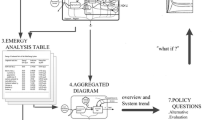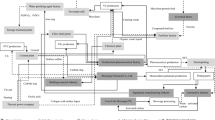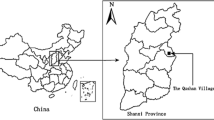Abstract
The emergy analysis was used to evaluate the sustainability of a village which aims to be ecologically friendly. The choice of focusing on the use of local resources including agriculture and farm goods, photovoltaic panels, renewable heating and cooling systems, recycled water from constructed wetlands etc., aims to obtain a sustainable village. Indices and ratios based on emergy flows have been calculated and used to evaluate the behaviour of the whole system. Their dependence upon the fraction of renewable and non renewable inputs as well as locally available versus purchased inputs from outside is stressed. A new index of sustainability (SI) is also applied to the case study.



Similar content being viewed by others

References
Brown, M. T, & Buranakarn, V. (2003). Emergy indices and ratios for sustainable material cycles and recycle options. Resources Conservation and Recycling, 38, 1–22.
Brown, M. T., & Ulgiati, S. (2004). Energy quality, emergy and transformity: H.T. Odum’s contributions to quantifying and understanding systems. Ecological Modelling, 178, 201–213.
Costanza, R., & Daly, H. (1982). Natural capital and sustainable development. Conservation Biology, 6, 1.
Odum, H. T. (1996). Environmental accounting: Emergy and environmental decision making. New York: John Wiley and Sons.
Odum, H. T. (2000). Emergy accounting, environmental engineering sciences. Gainesville, Florida, USA: University of Florida.
Odum, H. T., & Pinkerton, R. C. (1955). Time’s speed regulator: The optimum efficiency for maximum power output in physical and biological systems. American Scientist, 43, 331–343.
Siracusa, G., & La Rosa, A. D. (2006). Design of a constructed wetland for wastewater treatment in a Sicilian town and environmental evaluation using the emergy analysis. Ecological Modelling, 197, 490–497.
Tiezzi, E. (1995). Verso uno sviluppo sostenibile. Oikos-Ekoblub, 1, 4–6.
Tiezzi, E. (2002). Analisi emergetica della Provincia di Bologna, Provincia di Bologna settore Ambiente.
Ulgiati, S., Brown, M. T., Bastianoni, S., & Marchettini, N. (1995). Emergy-based indices and ratios to evaluate the sustainable use of resources. Ecological engineering, 5, 519–531.
Ulgiati, S., & Brown, M. T. (1998). Monitoring patterns of sustainability in natural and man-made ecosystems. Ecological Modelling, 108, 23–36.
Ulgiati, S., Odum, H. T., & Bastianoni, S. (1994). Emergy use, environmental loading and sustainability. An emergy analysis of Italy. Ecological Modelling, 73, 215–268.
Author information
Authors and Affiliations
Corresponding author
Additional information
Readers should send their comments on this paper to BhaskarNath@aol.com within 3 months of publication of this issue.
Rights and permissions
About this article
Cite this article
Siracusa, G., La Rosa, A.D., Palma, P. et al. New frontiers for sustainability: emergy evaluation of an eco-village. Environ Dev Sustain 10, 845–855 (2008). https://doi.org/10.1007/s10668-007-9087-2
Received:
Accepted:
Published:
Issue Date:
DOI: https://doi.org/10.1007/s10668-007-9087-2



